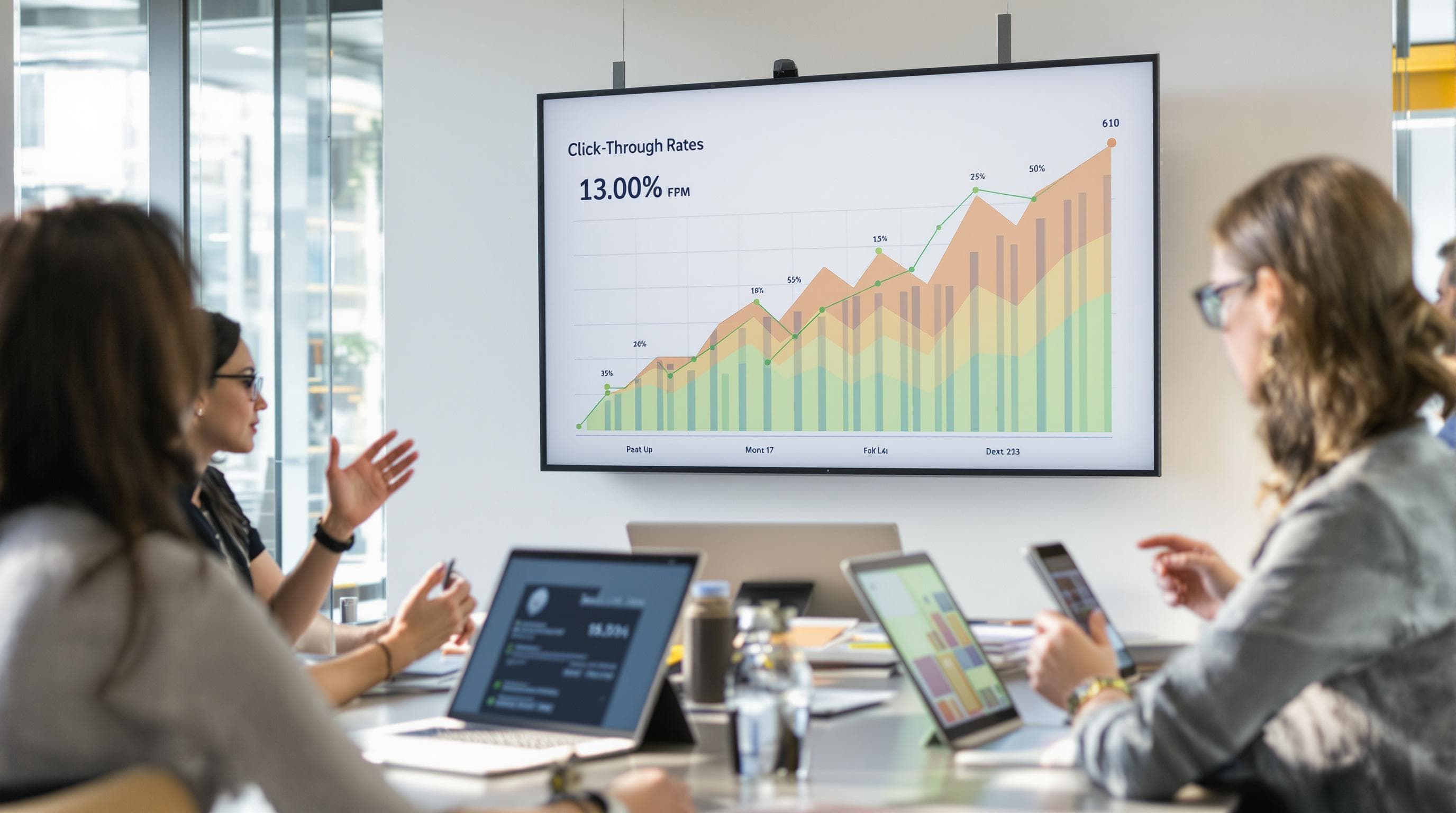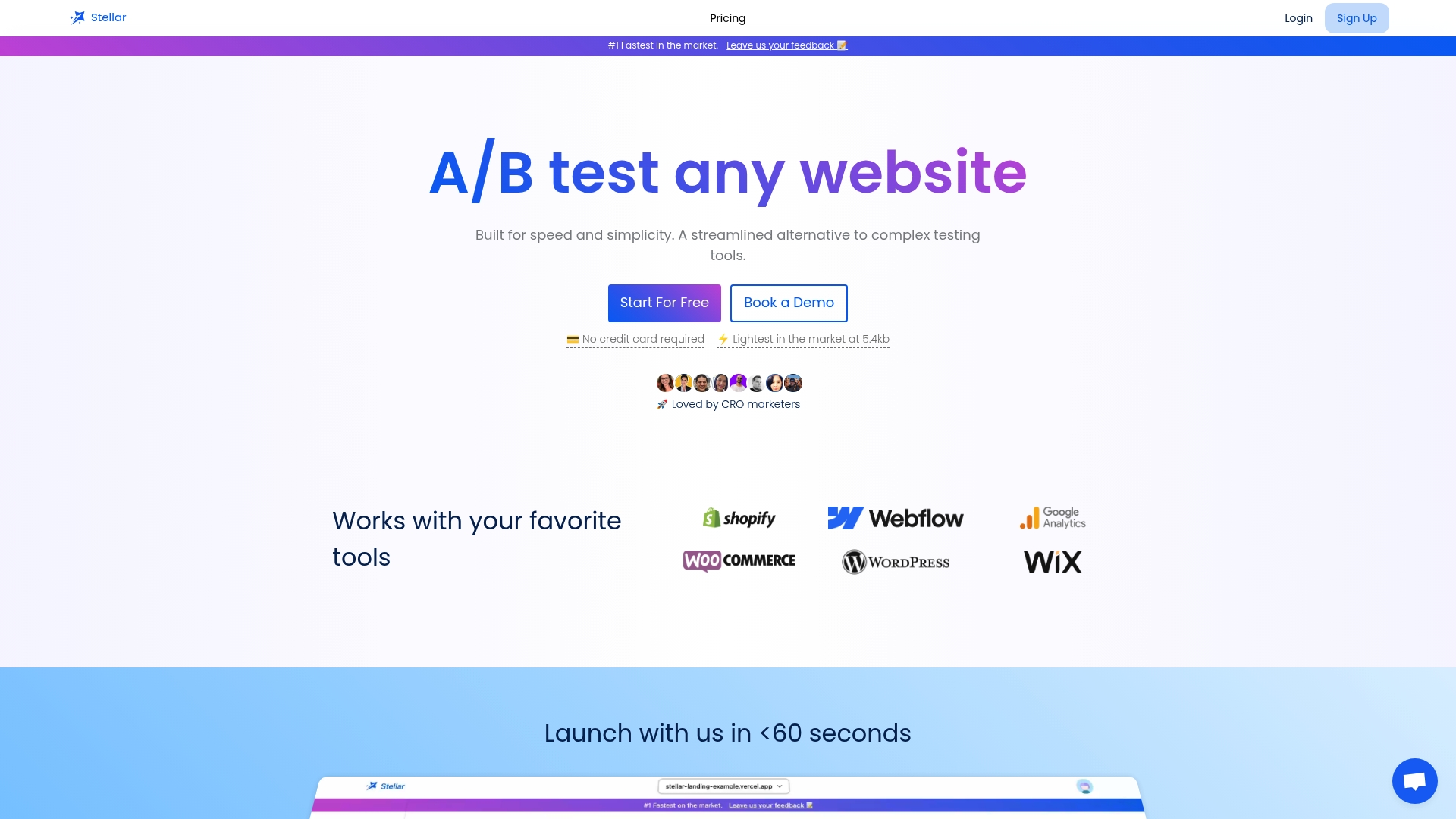
Understanding Click-Through Rates: Essential Guide for Marketers 2025

Click-through rates might seem like just another marketing number, but they actually reveal how well your message connects with real people. Here is something that might surprise you. In 2025, the average click-through rate for Google Search Ads has climbed to 6.66 percent, with some industries spiking above 13 percent. What most marketers miss is that chasing the numbers alone gets you nowhere. The real edge lies in understanding why people click in the first place—and that secret is more psychological than mathematical.
Table of Contents
- What Click-Through Rates Mean In Marketing
- The Fundamental Mechanics Of Click-Through Rates
- Strategic Significance In Digital Marketing
- Key Factors Influencing Click-Through Rates
- Psychological And Design Elements
- Targeting And Personalization Dynamics
- Technical And Content Optimization Strategies
- How To Analyze And Improve Your CTR
- Advanced Analytics And Predictive Modeling
- Strategic Optimization Techniques
- Experimental Approaches And Machine Learning
- Click-Through Rates Benchmarks For 2025
- Search And Paid Advertising Benchmarks
- Email Marketing Performance Metrics
- Social Media And Display Advertising Benchmarks
Quick Summary
| Takeaway | Explanation |
|---|---|
| Understanding CTR Calculation | Click-through rates (CTR) are calculated by dividing the number of clicks by total impressions and multiplying by 100, highlighting content relevance and audience engagement. |
| Importance of Targeting and Personalization | Effective targeting and personalization, based on demographic and behavioral insights, significantly enhance CTR by ensuring content resonates with the audience. |
| Continuous Optimization Approach | Improving CTR requires a systematic approach involving advanced analytics, A/B testing, and machine learning to refine marketing messages and user experiences. |
| Sector-Specific Benchmark Awareness | Marketers should recognize that CTR benchmarks vary by industry, using them as strategic guidelines to set realistic campaign objectives and optimize performance. |
| Holistic View of Marketing Metrics | CTR should be analyzed in conjunction with other metrics, such as conversion rates and ROI, to develop a comprehensive understanding of campaign effectiveness. |
What Click-Through Rates Mean in Marketing
Click-through rates represent a critical performance metric that reveals how effectively digital marketing content connects with its intended audience. At its core, CTR measures the percentage of people who take a specific action by clicking on an advertisement, email link, or webpage element compared to the total number of individuals who view that content.
The Fundamental Mechanics of Click-Through Rates
Understanding click-through rates begins with a precise calculation. According to Investopedia, CTR is computed by dividing the number of clicks by the total number of impressions and multiplying by 100 to generate a percentage. For instance, if an online advertisement receives 500 clicks from 25,000 total impressions, the CTR would be 2%.
This metric serves as a powerful indicator of content relevance and audience engagement. A high CTR signals that the marketing message resonates with viewers, compelling them to take immediate action. Conversely, a low CTR suggests that the content might need strategic refinement to better capture audience attention.
Strategic Significance in Digital Marketing
Adjust.com emphasizes that CTR is more than just a number. It provides critical insights into campaign performance across various digital channels. Marketers use this metric to:
- Evaluate Content Effectiveness: Determine how well marketing messages connect with target audiences
- Optimize Advertising Strategies: Identify which ads, keywords, and designs generate the most user engagement
- Improve Targeting Precision: Refine audience segmentation based on interaction patterns
Professional marketers recognize that click-through rates offer a direct window into audience behavior. They represent more than statistical data. CTR is a real-time feedback mechanism that guides strategic decision-making in digital marketing campaigns.
The nuanced interpretation of CTR requires understanding context. Different industries and marketing channels naturally exhibit varying benchmark rates. What constitutes a strong CTR in email marketing might differ significantly from acceptable rates in display advertising.
Advanced marketers approach CTR as a dynamic metric. They continuously test and optimize elements like headline copy, visual design, call-to-action placement, and targeting parameters. By systematically analyzing these components, they can incrementally improve performance and drive more meaningful user interactions.
While CTR provides valuable insights, it remains just one piece of the broader marketing analytics puzzle. Savvy professionals combine CTR data with conversion rates, engagement metrics, and return on investment calculations to develop a comprehensive understanding of marketing performance.
Ultimately, click-through rates serve as a critical diagnostic tool. They help marketers answer fundamental questions about audience interest, content effectiveness, and strategic alignment. By paying close attention to these metrics, marketing teams can make data-driven decisions that enhance overall campaign success.
Key Factors Influencing Click-Through Rates
Click-through rates are not random occurrences but the result of carefully orchestrated marketing elements that compel users to take action. Understanding the multifaceted factors that drive CTR can transform marketing strategies from guesswork to precision targeting.
Psychological and Design Elements
Research published in Cyberpsychology and Behavior reveals that user engagement is deeply rooted in psychological triggers. Product involvement, content congruency, and user attitudes play crucial roles in determining whether an individual will click on an advertisement.
Visual design emerges as a critical factor in attracting user attention. The color scheme, typography, and overall aesthetic composition of marketing materials can significantly impact click-through rates. Elements like contrast, white space, and strategic placement of call-to-action buttons can mean the difference between user engagement and total disinterest.
Psychological principles such as social proof, scarcity, and urgency also drive click-through behavior. When users perceive limited availability or witness widespread endorsement, they become more likely to interact with marketing content.

Targeting and Personalization Dynamics
Research from the 2024 International Conference on Human-Computer Interaction demonstrates that personalization is not just a buzzword but a critical CTR enhancement strategy. Factors like past purchase history, recent purchase dates, and cumulative purchase frequency dramatically influence user engagement.
Effective targeting requires a nuanced understanding of audience segments. Marketers must consider:
- Demographic Precision: Age, location, income level, and professional background
- Behavioral Insights: Previous interactions, browsing history, and engagement patterns
- Contextual Relevance: Alignment between user interests and marketing message
Technical and Content Optimization Strategies
Technical elements play an equally significant role in click-through rates. Page load speed, mobile responsiveness, and overall user experience directly impact user willingness to engage. A millisecond delay can translate into substantial drop-offs in user interaction.
Content quality remains paramount. Compelling headlines, clear value propositions, and concise messaging can dramatically improve CTR. Users are more likely to click when they immediately understand the benefit or solution being offered.
Advanced marketers leverage A/B testing to systematically optimize these factors. By creating multiple variations of marketing content and rigorously analyzing performance, they can incrementally improve click-through rates.
Understanding click-through rates requires a holistic approach. It is not about implementing isolated tactics but creating a comprehensive strategy that considers psychological, technical, and content-related dimensions. Successful marketers view CTR as a dynamic metric that reflects the intricate interplay between user expectations and marketing execution.
How to Analyze and Improve Your CTR
Analyzing and improving click-through rates requires a systematic approach that combines data-driven insights, strategic experimentation, and continuous optimization. Marketers must move beyond surface-level metrics to develop a comprehensive understanding of user interaction patterns.
Advanced Analytics and Predictive Modeling
Cutting-edge research from the Journal of Big Data introduces sophisticated approaches to CTR prediction. The study proposes an innovative model that integrates user interest with multi-head attention mechanisms, allowing for more nuanced understanding of user behavior.
Effective CTR analysis involves multiple layers of investigation:
- Granular Segmentation: Break down performance by audience demographics, device types, and content categories
- Behavioral Pattern Recognition: Identify recurring interaction trends
- Comparative Performance Tracking: Benchmark current results against historical data and industry standards
Strategic Optimization Techniques
Research from the 2024 Consumer Electronics Retail Study reveals critical insights for improving click-through rates. The study emphasizes the importance of targeting strategies based on:
- Customer loyalty metrics
- Past purchase history
- Recency of customer interactions
- Cumulative purchase frequency
Professional marketers recognize that CTR improvement is not a one-time effort but a continuous process of refinement. This requires implementing a robust testing framework that systematically evaluates different marketing elements.
Experimental Approaches and Machine Learning
Advanced research from Cornell University introduces the Decision-Making Context Interaction Network (DCIN), a groundbreaking approach to understanding user click behaviors. This methodology demonstrates how machine learning can provide deeper insights into user interaction patterns.
Key strategies for CTR improvement include:
- Conducting regular A/B tests on design elements
- Implementing personalization techniques
- Utilizing predictive analytics to anticipate user preferences
- Developing more sophisticated targeting algorithms
Technology continues to transform CTR analysis. Machine learning models now offer unprecedented capabilities in predicting and improving user engagement. These advanced systems can process complex datasets, identifying subtle patterns that human analysts might overlook.
The most successful marketers approach CTR as a dynamic, evolving metric. They combine statistical analysis, psychological insights, and cutting-edge technology to create more compelling user experiences. By treating CTR as a comprehensive indicator of marketing effectiveness, teams can develop more targeted, responsive strategies that drive meaningful engagement.
Ultimately, improving click-through rates is about understanding the intricate relationship between user expectations and marketing delivery. It requires a holistic approach that balances data-driven insights with creative problem-solving.
Click-Through Rates Benchmarks for 2025
Navigating the digital marketing landscape requires a comprehensive understanding of current click-through rate benchmarks. These performance metrics provide critical insights into industry standards and help marketers set realistic expectations for their campaigns.
Search and Paid Advertising Benchmarks
LocalIQ's 2025 Digital Marketing Research reveals fascinating trends in search advertising performance. Across industries, the average click-through rate for Google Search Ads stands at 6.66%, with significant variations between sectors.
Industry-specific CTR performance highlights include:
- Arts & Entertainment: Highest performing sector with 13.10% CTR
- Dentists & Dental Services: Lowest CTR at 5.44%
- Technology and Software: Moderate performance range between 7-9%
These variations underscore the importance of understanding sector-specific benchmarks. What constitutes a strong CTR in one industry might be considered underperforming in another.
Here is a table summarizing 2025 CTR benchmarks for key sectors in search, email, and social media advertising. This comparison can help marketers quickly spot industry differences and set more realistic performance goals.
| Channel/Industry | Average CTR (%) | Highest/Lowest Industry Performance |
|---|---|---|
| Google Search Ads (Overall) | 6.66 | Arts & Entertainment: 13.10% / Dentists: 5.44% |
| Technology (Google Search Ads) | 7.0 – 9.0 | - |
| Email Marketing (Overall) | 5.14 | Automotive: 5.76% / Arts & Ent.: 4.16% |
| Technology (Email) | 4.5 – 5.2 | - |
| Facebook Ads (All Industries) | 1.5 – 1.8 | - |
Email Marketing Performance Metrics
MailMunch's 2025 Email Marketing Report provides detailed insights into email campaign click-through rates. The average CTR across industries hovers around 5.14%, with notable sector variations:
- Automotive Industry: Leading email CTR at 5.76%
- Arts & Entertainment: Experiencing 4.16% CTR
- Technology Sector: Averaging between 4.5-5.2% CTR
Email marketing continues to demonstrate robust engagement potential. The key to success lies in precise targeting, compelling content, and strategic segmentation.
Social Media and Display Advertising Benchmarks
AdBacklog's 2025 Digital Advertising Analysis reveals nuanced performance metrics for social media advertising. Facebook Ads show an average click-through rate ranging between 1.5% and 1.8% across different industries.
Marketing professionals must recognize that these benchmarks are not static targets but dynamic indicators of performance potential. Factors such as audience targeting, ad creative quality, and platform-specific algorithms significantly impact click-through rates.
Below is a table highlighting key factors that influence CTR, organized by category. This overview helps marketers prioritize areas for optimization in their campaigns.
| Factor Category | Key Influencing Elements |
|---|---|
| Psychological/Design | Visual design, color scheme, CTA placement, social proof, scarcity, urgency |
| Targeting | Demographic precision, behavioral insights, contextual relevance, purchase history |
| Technical | Page load speed, mobile responsiveness, user experience |
| Content | Headlines, value proposition clarity, concise messaging |
| Testing/Optimization | A/B testing, analytics, continuous refinement |
Successful marketers approach these benchmarks as strategic guidelines rather than absolute performance limits. They use these metrics to:
- Identify performance gaps
- Set realistic campaign objectives
- Develop targeted optimization strategies
- Compare performance against industry standards
The landscape of digital marketing continues to evolve rapidly. While these 2025 benchmarks provide valuable insights, they should be viewed as part of a broader, dynamic marketing ecosystem. Continuous testing, learning, and adaptation remain crucial for maintaining competitive marketing performance.
Ultimately, understanding click-through rate benchmarks is about context. These numbers tell a story of audience behavior, market trends, and technological innovation. Marketers who can interpret these metrics with nuance and strategic thinking will be best positioned to drive meaningful engagement in an increasingly complex digital environment.
Frequently Asked Questions
What is a click-through rate (CTR) in digital marketing?
Click-through rate (CTR) measures the percentage of users who click on a specific link or advertisement out of the total number of users who view it. It's calculated by dividing the number of clicks by the total impressions and multiplying by 100.
Why is click-through rate important for marketers?
CTR is crucial for marketers as it indicates how effectively their content engages the audience. A high CTR suggests that the message resonates well with viewers, driving them to take action, while a low CTR may indicate the need for content refinement.
How can I improve my click-through rate?
Improving CTR involves a combination of strategies, including optimizing ad designs, enhancing targeting and personalization, A/B testing different elements, and ensuring high-quality content that addresses user needs effectively.
What are the average click-through rates across different channels in 2025?
As of 2025, the average CTR for Google Search Ads is 6.66%, with significant industry variations. For email marketing, the average is 5.14%, and Facebook Ads see CTRs between 1.5% and 1.8%. Understanding these benchmarks helps marketers set realistic campaign goals.
Ready to Turn Click Curiosity Into Real Results?
If you read through the guide on click-through rates, you already know how critical it is to translate audience interest into measurable action. The article outlines that simply tracking CTR is no longer enough in 2025. Today, success depends on doing smarter testing, making adjustments quickly, and using real-time insights to boost engagement. Many marketers and product managers struggle to move from just watching numbers to actually improving them. If you have ever felt frustrated by slow A/B testing tools or analytics that deliver too late, you are not alone.

See how Stellar bridges the gap. With a no-code visual editor, streamlined A/B testing, and real-time analytics, Stellar empowers you to act on your data instantly. Try the fastest platform for experiments that reveal what drives the highest CTR. Businesses with less than 25000 monthly tracked users can even get started for free. Visit the Stellar homepage now to run your first test and see how easy it is to boost engagement and conversions.
Recommended
Published: 7/15/2025